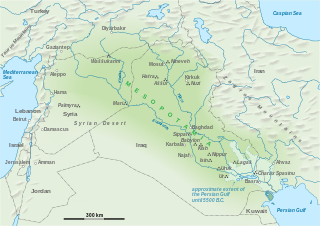Aramaic is a Northwest Semitic language that originated in the ancient region of Syria and quickly spread to Mesopotamia, the southern Levant, southeastern Anatolia, Eastern Arabia and the Sinai Peninsula, where it has been continually written and spoken in different varieties for over three thousand years.

Chaldea was a small country that existed between the late 10th or early 9th and mid-6th centuries BC, after which the country and its people were absorbed and assimilated into the indigenous population of Babylonia. Semitic-speaking, it was located in the marshy land of the far southeastern corner of Mesopotamia and briefly came to rule Babylon. The Hebrew Bible uses the term כשדים (Kaśdim) and this is translated as Chaldaeans in the Greek Old Testament, although there is some dispute as to whether Kasdim in fact means Chaldean or refers to the south Mesopotamian Kaldu.
Assyrian language may refer to:

Assyrians are an indigenous ethnic group native to Mesopotamia, a geographical region in West Asia. Modern Assyrians descend directly from the ancient Assyrians, one of the key civilizations of Mesopotamia. While they are distinct from other Mesopotamian groups, such as the Babylonians, they share in the broader cultural heritage of the Mesopotamian region. Modern Assyrians may culturally self-identify as Syriacs, Chaldeans, or Arameans for religious, geographic, and tribal identification.
The Arameans, or Aramaeans, were a tribal Semitic people in the ancient Near East, first documented in historical sources from the late 12th century BC. Their homeland, often referred to as the land of Aram, originally covered central regions of modern Syria.

The Chaldean Catholic Church is an Eastern Catholic particular church in full communion with the Holy See and the rest of the Catholic Church, and is headed by the Chaldean Patriarchate. Employing in its liturgy the East Syriac Rite in the Syriac dialect of the Aramaic language, it is part of Syriac Christianity. Headquartered in the Cathedral of Our Lady of Sorrows, Baghdad, Iraq, since 1950, it is headed by the Catholicos-Patriarch Louis Raphaël I Sako. According to a 1950 CIA report on Iraq, Chaldean Catholic Assyrians numbered 98,000 and were the largest Christian minority. In the late 2010s, it had a membership of 616,639, with a large population in diaspora and its home country of Iraq.
Biblical Aramaic is the form of Aramaic that is used in the books of Daniel and Ezra in the Hebrew Bible. It should not be confused with the Targums – Aramaic paraphrases, explanations and expansions of the Hebrew scriptures.
Suret, also known as Assyrian, refers to the varieties of Northeastern Neo-Aramaic (NENA) spoken by Christians, namely Assyrians. The various NENA dialects descend from Old Aramaic, the lingua franca in the later phase of the Assyrian Empire, which slowly displaced the East Semitic Akkadian language beginning around the 10th century BC. They have been further heavily influenced by Classical Syriac, the Middle Aramaic dialect of Edessa, after its adoption as an official liturgical language of the Syriac churches, but Suret is not a direct descendant of Classical Syriac.
Senaya or Sanandaj Christian Neo-Aramaic is a dialect of Northeastern Neo-Aramaic originally spoken by Christians in Sanandaj, Kurdistan Province in Iran. Most speakers now live in California, United States and few families still live in Tehran, Iran. They are mostly members of the Chaldean Catholic Church. Senaya is significantly different from Sanandaj Jewish Neo-Aramaic.
Soreth is the name given to a number of modern Syriac languages:

Beth Nahrain ; lit. 'home of the (two) rivers' is the name for the region known as Mesopotamia in the Syriac language. Geographically, it refers to the areas between and surrounding the Euphrates and Tigris rivers. The Aramaic name also refers to the area around the rivers, not only literally between the rivers.
The Neo-Aramaic or Modern Aramaic languages are varieties of Aramaic that evolved during the late medieval and early modern periods, and continue to the present day as vernacular (spoken) languages of modern Aramaic-speaking communities. Within the field of Aramaic studies, classification of Neo-Aramaic languages has been a subject of particular interest among scholars, who proposed several divisions, into two, three or four primary groups.
Aramaic history may refer to:

The Assyrian homeland or Assyria, refers to the homeland of the Assyrian people within which Assyrian civilisation developed, located in their indigenous Upper Mesopotamia. The territory that forms the Assyrian homeland is, similarly to the rest of Mesopotamia, currently divided between present-day Iraq, Turkey, Iran and Syria. In Iran, the Urmia Plain forms a thin margin of the ancestral Assyrian homeland in the north-west, and the only section of the Assyrian homeland beyond the Mesopotamian region. The majority of Assyrians in Iran currently reside in the capital city, Tehran.

Terms for Syriac Christians are endonymic (native) and exonymic (foreign) terms, that are used as designations for Syriac Christians, as adherents of Syriac Christianity. In its widest scope, Syriac Christianity encompass all Christian denominations that follow East Syriac Rite or West Syriac Rite, and thus use Classical Syriac as their main liturgical language. Traditional divisions among Syriac Christians along denominational lines are reflected in the use of various theological and ecclesiological designations, both historical and modern. Specific terms such as: Jacobites, Saint Thomas Syrian Christians, Maronites, Melkites, Nasranis, and Nestorians have been used in reference to distinctive groups and branches of Eastern Christianity, including those of Syriac liturgical and linguistic traditions. Some of those terms are polysemic, and their uses have been a subject of terminological disputes between different communities, and also among scholars.
Eastern Aramaic refers to a group of dialects that evolved historically from the varieties of Aramaic spoken in the core territories of Mesopotamia and further expanded into northern Syria, eastern Arabia and northwestern Iran. This is in contrast to the Western Aramaic varieties found predominantly in the southern Levant, encompassing most parts of modern western Syria and Palestine region. Most speakers are Assyrians, although there is a minority of Mizrahi Jews and Mandaeans who also speak modern varieties of Eastern Aramaic.
Old Aramaic refers to the earliest stage of the Aramaic language, known from the Aramaic inscriptions discovered since the 19th century.

Aramaic studies are scientific studies of the Aramaic languages and literature. As a specific field within Semitic studies, Aramaic studies are closely related to similar disciplines, like Hebraic studies and Arabic studies.





